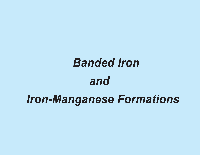 | Here
are teaching slides for Banded Iron & Iron-Manganese Formations.
You can see a full-size version by clicking on the thumbnail. You can then
download that slide individually by right mouse clicking on it; using the "Save
As" command in the File menu; or in most cases, by simply dragging it to your
desktop.
|
|
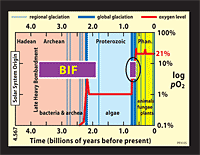 | 3.2:
Distribution of banded iron formations (BIF) over geologic time and their
temporal relation to glacial epochs (blue bars) and the inferred history
of atmospheric oxygen. Note the isolated recurrence of BIF associated with
Cryogenian glaciation.
|
|
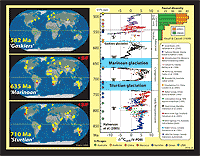 | 3.3:
Present global distribution of Sturtian, Marinoan and Ediacaran glacial
and glacial-marine
deposits (left), and secular variation in the carbon isotopic composition
(?13C) of marine carbonates (right) from 860 to 490 Ma (modified after
Halverson et al., 2005) and their relation to the three glacial epochs
and early faunal diversification (after Knoll and Carroll, 1999).
|
|
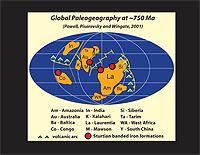 | 3.4:
Global paleogeography at ~750 Ma, after Powell et al. (2001), showing locations
of banded iron formations (red dots) associated with the Sturtian glaciation.
|
|
 | 3.5:
Banded iron formation with ice-rafted debris and redeposited diamictite
from the older Cryogenian (Sturtian) glaciation (Sayunei Formation, Rapitan
Group) in the Mackenzie Mountains, northern Canadian Cordillera (left).
Black Sea (right), a modern anoxic sulfidic marine basin from which iron
is removed as sulfide and not BIF-precursor (iron oxy-hydroxides).
|
|
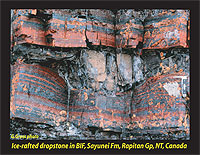 | 3.6:
Ice-rafted dropstone (dolostone) in banded iron formation of the Sayunei
Formation (Rapitan Group), Mackenzie Mountains, northern Canadian Cordillera.
|
|
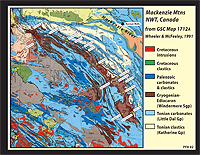 | 3.7:
Geological map of the Mackenzie Mountains and vicinity in the external
zone of the northern Canadian Cordillera. Yellow dots indicate sections
studied by P.F. Hoffman and associates, 2001-2004.
|
|
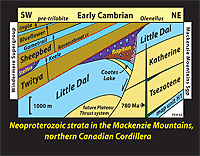 | 3.8:
Restored cross-section of Neoproterozoic strata in the Mackenzie Mountains,
northern Canadian Cordillera. Blue, carbonate; brown, shale; green, gabbro;
purple, diamictite; red, cap carbonate; yellow, quartzite. Plateau thrust
sheet, in which the Windermere Supergroup is principally exposed, is interpreted
as an inverted rift-basin (amagmatic) of Coates Lake and Rapitan group
age.
|
|
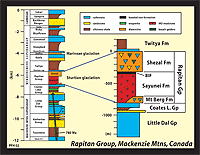 | 3.9:
Stratigraphy of the Rapitan Group and its setting within the Neoproterozoic
and Cambrian succession in the Mackenzie Mountains, northern Canadian Cordillera.
|
|
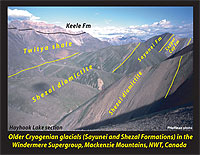 | 3.10:
Older Cryogenian glacials (Sayunei and Shezal Formations) exposed on the
frontal ramp of the Plateau Thrust near Hayhook Lake in the Mackenzie Mountains,
northern Canadian Cordillera.
|
|
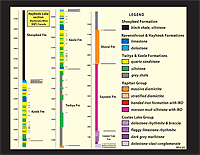 | 3.11:
Measured section of Cryogenian and early Ediacaran strata near Hayhook
Lake, Mackenzie Mountains, northern Canadian Cordillera.
|
|
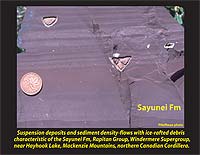 | 3.12:
Maroon mudstone with silty density-flows and ice-rafted carbonate debris
in characteristic basinal facies of the Sayunei Formation, Hayhook Lake
section.
|
|
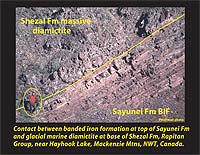 | 3.13:
Disconformity between banded iron formation (uppermost Sayunei Formation)
and diamictite (lowermost Shezal Formation) containing BIF clasts, Hayhook
Lake section.
|
|
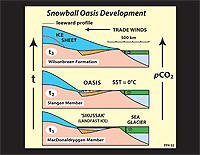 | 3.14:
Model of oasis development in a low-latitude silled basin during a snowball
glaciation.
|
|
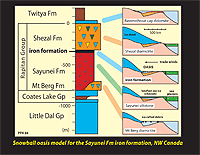 | 3.15:
Snowball oasis model for BIF deposition. BIF occurs where anoxic Fe(II)-rich
waters undergo atmospheric exchange, mixing with oxic subglacial meltwater,
or oxygenic photosynthesis beneath thin or intermittent ice.
|















